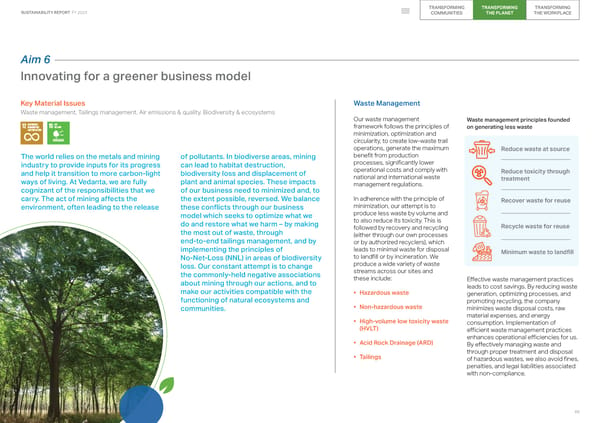TRANSFORMING TRANSFORMING TRANSFORMING SUSTAINABILITY REPORT FY 2023 COMMUNITIES THE PLANET THE WORKPLACE Aim 6 Innovating for a greener business model Key Material Issues Waste Management Waste management, Tailings management, Air emissions & quality, Biodiversity & ecosystems Our waste management Waste management principles founded framework follows the principles of on generating less waste minimization, optimization and circularity, to create low-waste trail operations, generate the maximum Reduce waste at source The world relies on the metals and mining of pollutants. In biodiverse areas, mining benefit from production industry to provide inputs for its progress can lead to habitat destruction, processes, significantly lower and help it transition to more carbon-light biodiversity loss and displacement of operational costs and comply with Reduce toxicity through ways of living. At Vedanta, we are fully plant and animal species. These impacts national and international waste treatment management regulations. cognizant of the responsibilities that we of our business need to minimized and, to carry. The act of mining affects the the extent possible, reversed. We balance In adherence with the principle of Recover waste for reuse environment, often leading to the release these conflicts through our business minimization, our attempt is to model which seeks to optimize what we produce less waste by volume and do and restore what we harm – by making to also reduce its toxicity. This is followed by recovery and recycling Recycle waste for reuse the most out of waste, through (either through our own processes end-to-end tailings management, and by or by authorized recyclers), which implementing the principles of leads to minimal waste for disposal Minimum waste to landfill No-Net-Loss (NNL) in areas of biodiversity to landfill or by incineration. We loss. Our constant attempt is to change produce a wide variety of waste the commonly-held negative associations streams across our sites and about mining through our actions, and to these include: Effective waste management practices make our activities compatible with the leads to cost savings. By reducing waste • Hazardous waste generation, optimizing processes, and functioning of natural ecosystems and promoting recycling, the company communities. • Non-hazardous waste minimizes waste disposal costs, raw material expenses, and energy • High-volume low toxicity waste consumption. Implementation of (HVLT) efficient waste management practices enhances operational efficiencies for us. • Acid Rock Drainage (ARD) By effectively managing waste and through proper treatment and disposal • Tailings of hazardous wastes, we also avoid fines, penalties, and legal liabilities associated with non-compliance. 68
 2023 ESG Report Page 67 Page 69
2023 ESG Report Page 67 Page 69